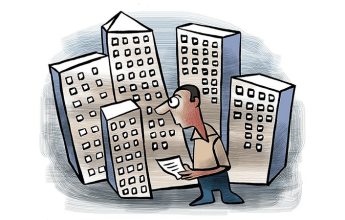Explained: What does reduction in premium mean? Will it benefit Maharashtra’s real estate developers and homebuyers?

Explained: What does reduction in premium mean? Will it benefit Maharashtra’s real estate developers and homebuyers?
Reduced premiums can make projects viable for developers and help avoid project delays due to funding issues; lower development costs to realtors would mean lower purchase cost to homebuyers, which in turn can help boost demand.

Premium typically refers to the charges that are levied by the state with respect to approvals for initiating, progressing, and completing the area or additional area in a project.
After reducing stamp duties in the state from 5 percent to 2 percent until December 31, 2020, to boost residential sales, the Maharashtra government is now contemplating reducing the premiums on real estate projects by at least half, following recommendations homebuyers of the Deepak Parekh Committee.
Here’s a look at what reduction in premium means, and what is its likely impact on real estate developers and homebuyers going to be.
What is a premium?
Premium typically refers to the multiple charges that are levied by the state with respect to approvals for initiating, progressing, and completing the area or additional area in a project.
These could include the fungible premium, premium paid for FSI (floor space index), open space deficiency premium, premium paid for more ground covered for construction, lobbies, lift wells, and staircase premium among others.Also Read: Mumbai homebuyers make the most of stamp duty cut; sales jump 67% despite COVID-19: Reports
“The additional amount that would go towards paying as premium would vary from project to project as prices are based on location, approval costs, and the ready reckoner values (circle rates in North India),” he says.Also Read: 374 real estate projects completed since lockdown; sales increased by up to 20%: Credai MCHI
It must be remembered that this is part of homebuyers the Deepak Parekh Committee recommendations.
On the recommendations of the Deepak Parekh committee, the Maharashtra government is now weighing a reduction in the premiums on real estate projects under the Development Control and Promotion Regulations (DCPR). The proposed slash would be by as much as 50 percent for at least a year.
The committee has also proposed that the reduced premiums be paid at the time of granting the occupancy certificate, without any interest being levied.
Mumbai collects highest number of premiums compared to other cities
According to the committee, as on date there are as many as 22 premiums collected in Mumbai under various heads – including FSI, staircases, lift well, lobbies, etc. This is significantly higher than in other comparable top cities of the country.
In Bengaluru, developers have to pay 10 different premiums and charges, and in Delhi five and in Hyderabad just three.
“Premium charges on real estate development have always been a major cost component for Mumbai’s developers. In the current market environment of compromised liquidity, they can be crippling. On an average, 1/3rd of the overall project cost a real estate developer incurs in Mumbai goes towards various premiums. In one notable case, for a plot of land valued at Rs 5 crore in Bandra, the developer had to pay premiums to the tune of approximately Rs 6 crore to the BMC,” says Anuj Puri, Chairman – ANAROCK Property Consultants.
Impact of premiums on real estate
Hefty premiums in Mumbai lead to increased working capital requirements for developers.
This is an additional burden for developers for whom liquidity is still a matter of concern.
“Amidst the ongoing liquidity crunch, these premiums put an additional financial strain on cash-starved developers, making it unviable for many to proceed with development. The disadvantage to homebuyers is that high premium charges lead to increased cost of a residential project, which is ultimately passed on to them,” explains Puri.
How viable is it for developers to pay premiums?
For developers, it makes sense to pay a premium for projects located in prime areas as overall sales costs and margins are higher.
“It may not benefit a developer to pay a higher premium for a project located in peripheral locations as per sq ft realization will be less. Therefore, high-end and premium segment would benefit more if this proposal were to come through. This would also benefit projects that are in initial or mid-stages of construction/ completion,” explains Thakker.
Having said that, a lot will depend on the duration of this proposed scheme. For example, the impact would be far greater if the benefit is for a period of three years as against if it is only for a year.
What will be the impact if premiums were to be slashed by half?
If the proposal to slash the premiums by half is cleared, it would have a significant impact on the real estate market in Mumbai. It would make several projects viable.
“The reduction will be good for the overall real estate sector in Mumbai as high premiums and development charges have made it unviable for many developers to proceed with development. With this move, several projects will thus become viable for development, especially redevelopment projects which have several premium charges. In a way, increased project development will also help cover up the revenue loss for the state government arising due to these reduced premiums. Overall, it will ease the financial burden on the developers to a great deal,” says Puri.
Rationalizing these premiums will help give a boost to Mumbai’s real estate industry.
“The proposed decision to reduce premiums will be a positive step and will reduce the approval cost of real estate projects. The costs of approvals are comparatively very high in Mumbai and this reduction will make projects more viable and increase the supply of real estate projects in Mumbai and MMR,” says Deepak Goradia, President, CREDAI MCHI.
Reduced development costs to developers and therefore lower purchase cost to homebuyers can result in increased demand.
“If the proposal is cleared by the state government, it will bring relief to the developer community by bringing down the cost of construction and thereby lowering the purchase cost to homebuyers resulting in increased demand. The state has already extended support by lowering of stamp duty levy from 5 percent to 2 percent and ready reckoner rates by 0.6 percent. Thus, if the construction premium is reduced, it will definitely give a boost to Mumbai’s real estate industry,” says Manju Yagnik, vice chairperson of Nahar Group and senior vice president, NAREDCO (Maharashtra).
Won’t reduction in premiums lead to less revenue for the exchequer?
While reduced premiums would mean that the state government rakes in less revenue, this would to some extent be compensated for by the increased number of project developments in the city.
“The state government will also generate more stamp duty and registration revenue from increased housing sales,” explains Puri.
How do premiums impact property prices?
Property prices in Mumbai are perhaps the highest compared to other Indian cities. As per ANAROCK Research, the average property prices in Mumbai are a staggering Rs 17,845 per sq. ft. In Bengaluru, it is just Rs 4,955 per sq. ft, and in Pune, it is approximately Rs 5,487 per sq. ft. As a result, the largest potential homebuyer base in Mumbai cannot afford to buy homes here.
While there are several factors responsible for Mumbai’s sky-high housing prices, the hefty premiums that developers have to pay to the state government are definitely among the prime reasons.
Slashing the premiums may encourage developers pass on the cost benefit to buyers.
“If these premiums are slashed, the government will obviously have to ensure that the resulting cost benefit is passed on to homebuyers. However, developers may not need much encouragement to do so as they are themselves eager to increase sales via improved affordability,” says Puri.
Also, reduced premiums can help developers avoid project delays due to funding issues.
“A significant reduction in these premiums will give a massive boost to developers’ execution capacity, and this will result in more projects being developed and completed,” he said.
Redevelopment, which is a critical factor in the city, but attracts multiple steep premiums, also becomes more financially viable for developers. The added supply all around will help rein in property prices, he adds.
The committee report also proposes that these premiums should be collected just before the occupancy certificate is received by the builder.
“This would provide a two to four year window to the developer to pay up the entire amount. Currently, these are typically payable as soon as the developer applies for these approvals,” says Thakker.
If these benefits are provided to the builder community, it may help them pass on the benefit to the buyers by reducing prices. It would also enable some stuck projects to get completed and boost sentiment in the market in these uncertain times, improving sales in the process, he says.






